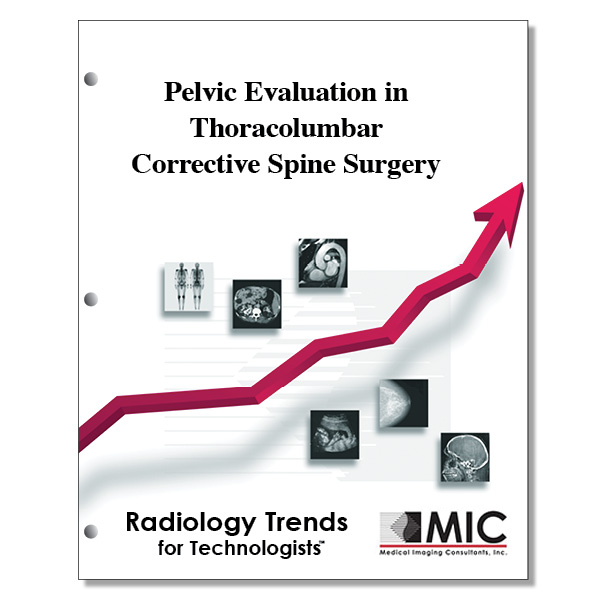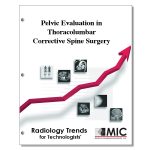

Pelvic Evaluation in Thoracolumbar Corrective Spine Surgery
A presentation of how pelvic compensation is used to maintain balance and posture by the scoliotic patient, and thus must be measured and accounted for in treatment options.
Course ID: Q00507 Category: Radiology Trends for Technologists Modality: Radiography1.75 |
Satisfaction Guarantee |
$24.00
- Targeted CE
- Outline
- Objectives
Targeted CE per ARRT’s Discipline, Category, and Subcategory classification for enrollments starting after February 14, 2023:
[Note: Discipline-specific Targeted CE credits may be less than the total Category A credits approved for this course.]
Computed Tomography: 1.00
Procedures: 1.00
Head, Spine, and Musculoskeletal: 1.00
Magnetic Resonance Imaging: 1.00
Procedures: 1.00
Neurological: 0.50
Musculoskeletal: 0.50
Radiography: 1.00
Procedures: 1.00
Head, Spine and Pelvis Procedures: 1.00
Registered Radiologist Assistant: 1.75
Procedures: 1.75
Musculoskeletal and Endocrine Sections: 0.75
Neurological, Vascular, and Lymphatic Sections: 1.00
Outline
- Introduction
- Cone of Economy
- Imaging and Measurement Technique
- The Concept of Coronal Balance and Important Radiologic Parameters
- Coronal Plane Decompensation
- Cobb Angles
- The Concept of Sagittal Balance and Important Radiologic Parameters
- Spinal Vertical Alignment
- Thoracic Kyphosis
- Lumbar Lordosis
- The Role of the Pelvis in Maintenance of Sagittal and Coronal Balance and Important Radiologic Parameters
- Pelvic Obliquity
- Pelvic Incidence
- Pelvic Tilt
- Sacral Slope
- T1 Pelvic Angle
- Bringing it all Together
- Summary
Objectives
Upon completion of this course, students will:
- be able to explain how the pelvis plays an important role in the maintenance of proper posture in patients with spinal deformities
- understand the role that the pelvis plays in coronal and sagittal balance
- understand how surgeons originally treated spinal deformities and the current change in mind set
- explain the changes in body mechanics in order to compensate for posture that is outside the normal comfort range
- be able to explain who introduced the “cone of economy” concept and what it is
- be able to explain the position that the patient should be in for radiographs for spinal deformities
- understand the benefits and limitation of using radiography in the evaluation of patients with spinal deformities
- understand the benefits and limitation of using computed tomography in the evaluation of patients with spinal deformities
- know what low-dose digital stereoradiography is and how it is used for imaging spinal deformities
- understand the benefits and limitation of using low-dose digital stereoradiography in the evaluation of patients with spinal deformities
- understand the benefits and limitation of using magnetic resonance (MR) imaging in the evaluation of patients with spinal deformities
- be able to describe the concepts of coronal balance in patients with spinal deformities and how it pertains to radiologic parameters
- be able to explain the physiologic factors that affect humans in standing upright while in the neutral midline posture
- know which two measurements are the most important ones in the interpretation of coronal balance from the standpoint of the spine and exclusive of the pelvis
- be able to describe how coronal plane decompensation is calculated
- know what is the most common spinal deformity that causes coronal plane decompensation
- be able to describe what the Cobb angle is, what the measurement determines, and how the angle affects treatment planning
- understand the principles of sagittal balance and how they pertain to patients with spinal deformities
- be able to describe the relevant radiologic parameters in the understanding of sagittal balance in patients with spinal deformities
- understand the basics of the SRS-Schwab Classification as a guideline for the interpretation and treatment of adult spinal deformities
- understand how thoracic kyphosis is calculated and the normal range of variances in men and women
- know how lumbar lordosis is calculated and what a Flatback deformity is
- be able to define what pelvic obliquity is and the role it plays in the coronal correction strategy of spinal deformities
- know how the pelvic incidence angle is created and its relationship to lumbar lordosis
- be able to define how pelvic tilt is calculated as well as how the SRS-Schwab Classification relates to pelvic retroversion
- be able to define how sacral slope is calculated and its relationship to pelvic tilt and incidence
- be able to define the T1 pelvic angle and how it relates to spinal vertical alignment and pelvic tilt measurements
- know what Ryan, et al, define as the ideal T1 pelvic angle for surgery
- understand the key information a radiologist should document on both AP and lateral radiographs of the spine for diagnosing spinal deformities
- be able to summarize the key measurement parameters that should be included in a radiologist report pertaining to spinal and pelvic radiography for diagnosing spinal deformities
